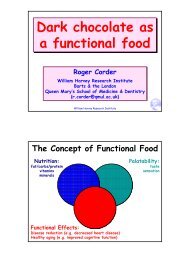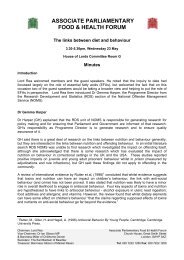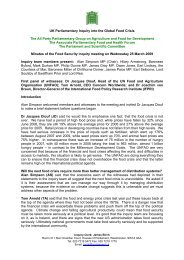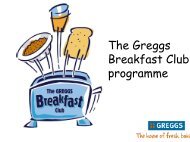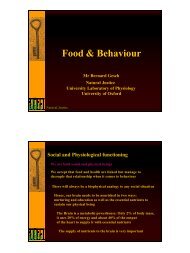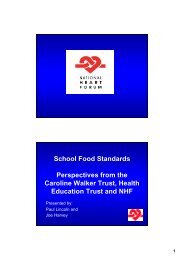Superfoods
Superfoods
Superfoods
- No tags were found...
Create successful ePaper yourself
Turn your PDF publications into a flip-book with our unique Google optimized e-Paper software.
To be covered: <strong>Superfoods</strong> vs whole diet approach Definition of a ‘superfood’ Potential benefits of superfoodconstituents Limitations of research vs food-baseddiet
Food classification By nutrient content:• Protein• Type of fat By ability to prevent disease:• Iron rich foods to correct anaemia• Vitamin D to prevent rickets By non-nutritive functional content:• Prebiotic fibres for gut bacteria• Plant phytochemicals as anti-oxidants
Food classification ‘Cultural’ superfoods:• Dominant staple / source of calories / essential ‘Prestige’ foods:• Difficult to obtain• Often protein based ‘Body image’ foods:• Tridosha• Yin-yang• Galenic humoral ‘Sympathetic magic’ foods:• Pomegranate• Walnut• Eggs ‘Physiological’ food groupsDerrick Jelliffe; AJCN 196
The ‘Mediterranean Diet’ Dr Ancel Keys 1904 - 2004 Physiologist at the Universityof Minnesota Director of the ‘SevenCountries Collaborative Study’ Dietary principles ratified insubsequent research of over450 clinical papers…..
12 studies addressing ‘Mediterranean Diet’1,574,299 subjects followed for 3-18 years … of which eight cohorts (514,816 subjects, 33,576 )9% reduction in overall mortality9% reduction in death from cardiovascular disease6% reduction in risk of cancer, or dying from cancer13% reduction in risk of Parkinson’s disease andAlzheimer’s diseaseSofi et al: BMJ 2008
Risk of developing, or dying from cancer:Risk of dying from heart disease:
Benefits of diet and lifestyle change:middle age 15,792 men and women aged 45 to 64, part of theAtherosclerosis Risk in Communities (ARIC) Study 970 (8.4%) newly adopted a healthy lifestyle:• at least 5 fruits and vegetables daily• at least 2.5 hours per week of exercise• maintain BMI between 18.5 – 30• stopped smokingOR95% CIHeart attack or strokeAll cause mortality0.650.600.39-0.920.39-0.92King et al; American Journal of Medicine 2007
Early nutrition research:the ‘ positive reductionist’ approachJames Lind Performed randomised controlled dietary trial Citrus fruits prevented scorbutic lesions (1753) 1794 – lime juice regularly given to sailors 1912 – chemical structure of Vitamin C identifiedTakaki Kanehiro Identified poor diet as a cause of beri-beri (1884) View against prevailing opinion that beri-beri wasan infectious disease 1910 - Umetaro Suzuki identifies chemical structure Eijkman identifies B1 and wins 1929 Nobel prize
Recent nutrition research:the ‘negative reductionist’ approach22 randomized controlled trials, 161,045 subjects88,610 in antioxidant supplement groups vs72,435 in placebo or no-intervention groups no preventive effect on cancer RR 0.99 (CI 0.96–1.03) no preventive effect on cancer according to type of antioxidant, ortype of cancer significant increased risk of bladder cancer RR 1.52 (CI 1.06–2.17)in a subgroup of four trialsMyung et al; Ann Oncol 201067 randomized controlled trials, 232,550 subjectsNo effect on primary or secondary prevention of disease,Vitamin A, selenium and Vitamin E supplements may increasemortalityBjelakovic et al: Cochrane Rev 2008
Superfood: a definition“a food consideredespecially nutritiousor otherwisebeneficial to healthand well-being”OEDTHE TIMES: Top 100 foods to boost productivity
<strong>Superfoods</strong> list, 2007 almonds aronia berry banana cauliflower cherry juice chocolate fig guava kiwi• mushrooms• oregano• quinoa• rabbit stew• seaweed andalgae shake• tea• tofu (-)• tomato• walnuts
Anti-oxidant potential Remove or reduce freeradicals or other reactiveoxygen species (ROS)that can cause celldamage facilitate anti-oxidantenzyme reactions Moderate the productionof toxic metabolites
Phase I detoxificationPhase I enzymes involved are 'activators'. Common enzymegroup are the CYP groups eg CYP450They alter the chemical your body needs to remove, by addingsingle nitrogen or oxygen molecules. This small change makessimpler for Phase II enzymes to effectively remove the substancOxidationReductionHydrolysisHydration
Phase II detoxificationPhase II enzymes called'excretors' bind to the byproductof Phase I enzymesThey conjugate with the alteredchemical such as glutathione.This makes the substance watersoluble, for easier transport andeliminationSulphationGlucuronidationAcetylationMethylationAmino acid conjugation
Hussain et al. Nature Reviews Cancer 3, 276 2003
Polyphenols:FlavonoidsPhenolic acidsPhenolicalcoholsStilbenesLignansFlavonols: tea, onionsFlavones: parsley, celeryFlavanones: citrus fruits, tomato, mintIsoflavones: soya, red cloverAnthocyanidins: red wine, black or red fruitsFlavanols: tea, wine, chocolateHydroxybenzoic acid: tea, blackberries, raspberriesHydroxycinnamic acids: coffee, blueberries, wheatTyrosol: extra-virgin olive oil, wine, beerResveratrol: grapes, berries, peanutsSecoisolariciresinol: flaxseedD’Archivio et al; 2007
Problems with food assays:unstable phytochemicalsIn vitro (‘test-tube’)degradation over timeOxidation of this anti-oxidant forms hydrogen peroxide+ quinonesShift oxidative damage from lipid peroxidation (cell membranes) to thiolarylation (less potent damage)Free radical toxicity is blocked BUT exchanged for a lesser type of toxicityDisadvantage in test tube monitoring – different in the body
Curcuminanti-inflammatory,antioxidant, andantitumour propertiesThe effects ofpolyphenols - such ascurcumin - are morepronounced in vitro, usinghigh concentrations whichare not physiologicallyachievable from food, invivo A clinical dose of 3.6gcurcumin is sufficient toachieve in vivobiochemical influenceThangapazham et al; AAPS Journal 2006
Curcumin (diferuloylmethane) Turmeric powder contains 3.1%curcumin by weight, so‘research-to-recipe’ equivalencewould require consumption of110g of turmeric powder daily‘Curry prevents cancer’ is clearlyan exaggeration of theknowledge currently availablepoor curcumin bio-availabilitycan be exploited to afford bowelprophylaxis for familialadenomatous polyposis – topicalinfluence reduces size andamount of pre-cancerous polypsforming in the large bowel
Phytochemical bioavailability:influenced by cooking Lycopene bio-availability increased 55%Increased naringeninIncreased carotene availabilityGlucosinolates:• Boiling 30 mins 70%• Steaming, microwaving, stir-frying nochange in bioavailabilityQuercetin:• 75% loss from boiling for 15 minutes• 65% after microwave cooking• 30% after frying
Physiological duration:pomegranate juice vs teaEllagitannins half life of 2-3 hoursSeeram et al; J Nutr 2006EGCG and other tea catechins half life of 2-4 hoursYan et al; J Nutr 2004
It’s inevitable that …“Food, not specific nutrients, is the fundamental unit tohealth in human nutrition”Professor Linda TapsellDirector of the Smart Foods CentreUniversity of Woolongong, W Australia“We are confusing ourselves and the public by talkingso much about nutrients when we should be talkingabout foods…”“consumers get the idea that diet and health can beunderstood in terms of specific nutrients”“It’s not the best approach and may be wrong”Professor David JacobsUniversity of Minnesota
Mediterranean diet:examples of dietary synergyVitamin D (oily fish) helps absorption of dietary calcium (dairyfoods, green leafy veg)Prebiotic fibres in vegetables and grain-based foods provide fuelsource for bowel or probiotic bacteria and increase mineralbioavailabilityOlive oil aids absorption of phytochemicals (such as lycopene,lutein) and fat soluble nutrients – vitamins including beta-caroteneMono-unsaturated fats reduce inflammation, as do fish oilsVitamin C helps to absorb non-meat sources of ironcitrus flavonoids eg quercetin + Vitamin C work synergistically
FA synthesisUrea cycle
Summary ‘Superfood’ is a marketing concept,exploiting the biological functionality offood compounds Cancer chemoprevention with dietaryphytochemicals continue to be evaluated A ‘whole diet’ approach is the optimalapproach to health: a ‘Superdiet’ ratherthan ‘Superfood’ approach



